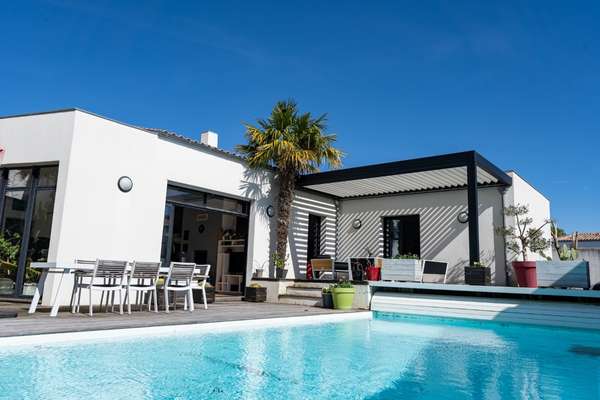Adding a roof to your pergola can transform this outdoor structure into a versatile, weather-resistant haven. By learning how to put a roof on a pergola, you not only enhance its functionality but also extend its usability throughout the year. This improvement provides valuable protection from the elements, ensuring comfort and enjoyment regardless of weather conditions. When planning this upgrade, it’s important to consider factors such as material durability, aesthetic appeal, and proper installation techniques to achieve the best results. Whether you aim to create a cozy retreat or a stylish entertainment space, adding a roof to your pergola is a worthwhile project that can significantly boost the value and enjoyment of your outdoor living area.
What Is The Best Material For A Pergola Roof?
The best material for a pergola roof depends on your specific needs and preferences. Some popular options include wood, metal, and polycarbonate. Wood adds a natural and rustic look to the pergola, while metal offers durability and strength. Polycarbonate is a lightweight and transparent material that allows light to filter through while providing protection from the elements.
Can I Install A Pergola Roof By Myself?
Yes, you can install a pergola roof by yourself, but it will require some level of skill and expertise in construction. Before starting the installation process, make sure to carefully read the manufacturer’s instructions and gather all the necessary tools and materials. It’s also important to have a clear understanding of the structural requirements and potential challenges that may arise during the installation.
How Do I Maintain A Pergola Roof?
Maintaining a pergola roof involves regular cleaning and inspection to ensure its longevity and functionality. Start by removing debris such as leaves, branches, and dirt from the roof surface using a broom or leaf blower. This will prevent buildup that can lead to mold or mildew growth.
Enhancing The Aesthetic Appeal

1. Adding Lights
Adding a roof to your pergola not only provides practical benefits but also significantly enhances its aesthetic appeal. One effective way to elevate the visual charm of your pergola is by adding lights. String lights, lanterns, or even built-in LED lighting can create a warm and inviting atmosphere, perfect for evening gatherings. By strategically placing lights under the roof, you can highlight the architectural features of the arbor, making it a focal point of your outdoor space.
2. Incorporating Plants
Incorporating plants is another excellent method to beautify your pergola when adding a roof. Hanging planters or climbing vines can introduce a touch of nature, creating a lush, green canopy that blends seamlessly with the roofing material. Consider selecting plants that thrive in your climate and require minimal maintenance to ensure they remain vibrant and healthy. The combination of greenery and a well-chosen ceiling can turn your pergola into a serene oasis, offering a perfect blend of shelter and natural beauty.
3. Using Decorative Elements
Using decorative elements is also a great method to enhance the appeal of your pergola with a roof. Consider adding curtains, outdoor rugs, or even art pieces to personalize the space. These elements can reflect your style and create a cohesive look that ties the pergola to the rest of your outdoor decor. Decorative touches like these can make the pergola a more inviting and enjoyable place, blending functionality with beauty seamlessly. By focusing on these enhancements, you can ensure that your arbor with a ceiling becomes a stylish and integral part of your outdoor living area.
Extended Usability

Putting a roof on your pergola significantly extends its usability, making it a functional outdoor space all year round. Whether you want to relax outside during a summer rain or need shade from the intense midday sun, an arbor roof provides the necessary protection. By learning how to put a roof on a pergola, you can create a versatile area that serves multiple purposes, such as an outdoor dining room, a serene reading nook, or a sheltered play area for kids. This enhancement not only maximizes the use of your outdoor space but also adds value to your property.
Metal Roofing

One popular option for adding a roof to your pergola is using metal roofing. Metal roofs are highly durable, offering excellent protection against various weather conditions, including rain, hail, and strong winds. They are also low-maintenance and long-lasting, which makes them a cost-effective choice in the long run. When considering putting a ceiling on an arbor, metal roofing stands out for its modern aesthetic and range of color options, allowing you to customize the look of your arbor to match your home’s exterior. This roofing solution ensures that your outdoor space remains stylish and functional throughout the seasons.
Wood Slats

For those who prefer a more natural and rustic look, wood slats are an excellent choice for roofing an arbor. Wood slats provide partial shade while allowing some sunlight to filter through, creating a cozy and inviting atmosphere. This option is perfect for those who want to maintain a connection with nature while enjoying the benefits of a sheltered space. When learning how to put a roof on a pergola, using wood slats can offer a beautiful, organic aesthetic that blends seamlessly with garden landscapes. Additionally, wood slats can be treated to withstand weather conditions, ensuring the longevity and durability of your ceiling.
Installation Procedure

To effectively get rid of gnats in your backyard, it is important to first identify the areas where they are breeding. Look for any standing water sources such as flower pots, bird baths, or clogged gutters where gnats may lay their eggs. Removing these water sources can significantly reduce the gnat population in your backyard.
Regular Inspection

Once you’ve successfully put a roof on your pergola, regular inspection becomes essential to maintain its effectiveness and prolong its lifespan. Schedule periodic inspections to assess the condition of the roofing material, checking for signs of wear, damage, or deterioration. Look for issues such as cracks, leaks, loose fasteners, or missing components, addressing them promptly to prevent further damage. Additionally, inspect the arbor structure itself, paying attention to any signs of stress, sagging, or instability that may indicate inadequate support for the ceiling. By conducting regular inspections and addressing any issues promptly, you can ensure that your arbor ceiling remains functional, safe, and aesthetically pleasing for years to come.
Ignoring Weather Conditions

Ignoring weather conditions when putting a roof on a pergola can lead to costly consequences and compromise the structure’s integrity. It’s essential to consider the local climate and weather patterns to select the appropriate roofing material and design. For example, areas prone to heavy rainfall may require a pitched roof with proper drainage to prevent water accumulation and potential leaks. Similarly, regions with high winds or extreme temperatures may necessitate reinforced roofing materials and sturdy construction to withstand the elements. Ignoring these factors can result in premature deterioration, structural damage, or even collapse during inclement weather. By acknowledging and accommodating weather conditions during the ceiling installation process, you can ensure a resilient and reliable addition to your arbor that enhances its functionality and longevity.
The Final Thought
Adding a roof to your pergola can greatly enhance its functionality and aesthetic appeal. By carefully considering the material, design, and installation process, you can create a comfortable outdoor space that provides shelter from the elements while maintaining an open and inviting atmosphere. Whether you choose a retractable canopy for versatility or opt for a solid roof for more permanent coverage, there are various options to suit your preferences and budget. Remember to prioritize safety by ensuring proper support structures and following manufacturer guidelines during installation. Take the time to plan and execute this project thoughtfully, and enjoy the benefits of a beautifully transformed pergola that enhances your outdoor living experience.
